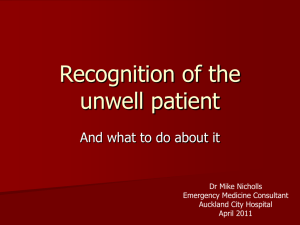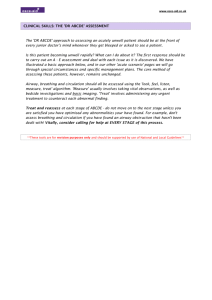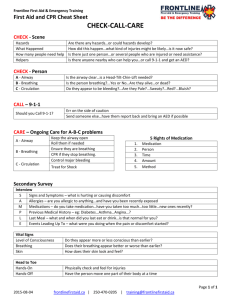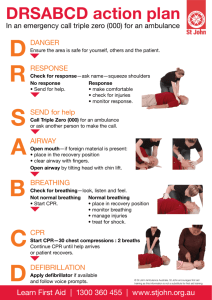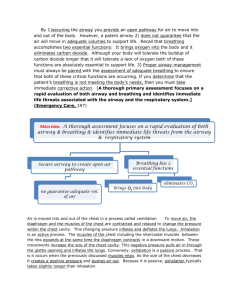ABCDE Approach to Critically Ill Patients
advertisement
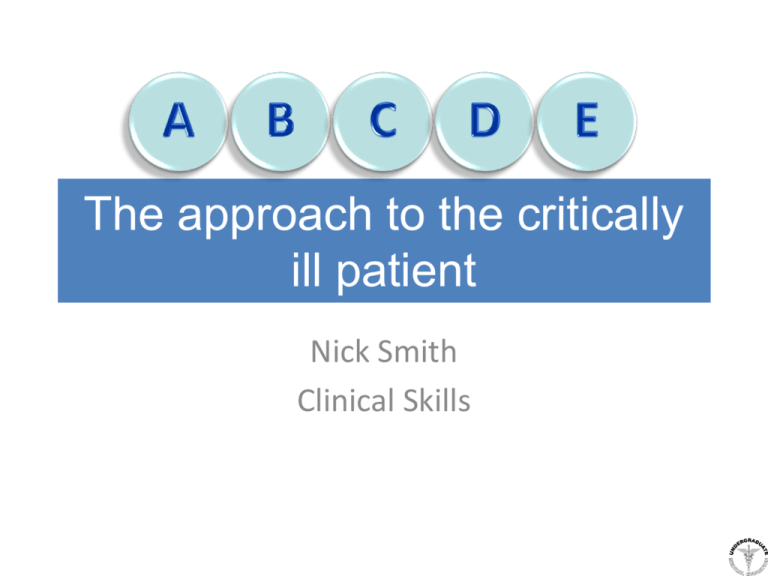
The approach to the critically ill patient Nick Smith Clinical Skills Objectives • • • • • The rational of ABCDE The process of primary & secondary survey Recognition of life threatening events Treatment of life-threatening conditions Handover Traditional medical approach History Examination Differential Investigations Diagnosis Treatment The ABCDE approach Airway & oxygenation A Exposure & examination E B D Disability due to neurological deterioration Breathing & ventilation C Circulation & shock management The principles • Perform primary ABCDE survey (5 min) • Instigate treatment for life threatening conditions as you find them • Reassess when any treatment is completed • Perform more detailed secondary ABCDE survey including investigations • If condition deteriorates repeat primary survey The primary survey • ABCDE assessment looking for immediately life threatening conditions • Rapid intervention usually includes max O2, IV access, fluid challenge +/- specific treatment • Should take no longer than 5 min • Can be repeated as many times as necessary • Get experienced help as soon as you need it • If you have a team delegate jobs The secondary survey • • • • • Performed when patient more stable Get a brief relevant HPC & Hx More detailed examination of patient (ABCDE) Order investigations to aid diagnosis IF PATIENT DETERIORATES RETURN TO PRIMARY SURVEY Airway - causes • • • • • • GCS Body fluids Foreign body Inflammation Infection Trauma Airway - assessment • Unresponsive • Added sounds – Snoring, gurgling, wheeze, stridor • Tracheal tug • Accessory muscles • See-saw respiratory pattern Airway – interventions (basic) • • • • • Head tilt chin lift Jaw thrust Suction Oral airways Nasal airways Airway – interventions (advanced) • GET HELP!!! • Nebulised adrenaline for stridor • LMA • Intubation • Cricothyroidotomy – Needle or surgical Once airway open... • Give 15 litres of oxygen to all patients via a nonrebreathing mask • For COPD patients re-assess after the primary survey has been complete & keep Sats 90-93% Breathing - causes • • • • • • • GCS Resp depressions Muscle weakness Exhaustion Asthma COPD Infection • • • • • • • Pulmonary oedema Pulmonary embolus ARDS Pneumothorax Haemothorax Open pneumothorax Flail chest Breathing - assessment • Look – Rate (<10 or >20), symmetry, effort, SpO2, colour • Listen – Taking: sentences, phrases, words – Bilateral air entry, wheeze, silent chest other added sounds • Feel – Central trachea, Percussion, expansion Breathing - interventions • Consider ventilation with AMBU™ bag if resp rate < 10 • Position upright if struggling to breath • Specific treatment – i.e.: β agonist for wheeze, chest drain for pneumothorax Circulation - assessment • • • • Look at colour Examine peripheries Pulse, BP & CRT Hypotension (late sign) – sBP< 100mmHg – sBP < 20mmHg below pts norm • Urine output • Consider compensation mechanisms Circulation – shock Inadequate tissue perfusion • Loss of volume – Hypovolaemia • Pump failure – Myocardial & nonmyocardial causes • Vasodilatation – Sepsis, anaphylaxis, neurogenic BP = HR x SV x SVR Circulation - interventions • Position supine with legs raised – Left lateral tilt in pregnancy • IV access - 16G or larger x2 – +/- bloods if new cannula • Fluid challenge – colloid or crystalloid? • ECG Monitoring • Specific treatment Disability - causes • • • • • • Inadequate perfusion of the brain Sedative side effects of drugs BM Toxins and poisons CVA ICP Disability - assessment • AVPU (or GCS) – Alert, responds to Voice, responds to Pain, Unresponsive • • • • Pupil size/response Posture BM Pain relief Disability - interventions • Optimise airway, breathing & circulation • Treat underlying cause – i.e.: naloxone for opiate toxicity – Caution if reversing benzo’s • Treat BM – 100ml of 10% dextrose (or 20ml of 50% dextrose) • Control seizures • Seek expert help for CVA or ICP Exposure • Remove clothes and examine head to toe front and back – Haemorrhage (inc concealed), rashes, swelling etc • Keep warm (unless post cardiac arrest) • Maintain dignity Secondary survey • Repeat ABCDE in more detail • History • Order investigations – ABG, CXR, 12 lead ECG, Specific bloods • Management plan • Referral • Handover Handover ITUATION ACKGROUND SSESSMENT ECCOMENDATION Situation • • • • Check you are talking o the right person State your name & department I am calling about... (patient) The reason I am calling is... Background • Admission diagnosis and date of admission • Relevant medical history • Brief summary of treatment to date Assessment • The assessment of the patient using the ABCDE approach Recommendation • • • • I would like you to... Determine the time scale Is there anything else I should do? Record the name and contact number of your contact Questions Summary • Assess ABCDE in turn • Instigate treatments for life-threatening problems as you find them • Reassess following treatment • If anything changes go back to A Acute severe asthma HR SVR Any one of: • PEF 33 – 50% of best or predicted • RR> 24 • HR> 110 • Inability to complete sentences in 1 breath • Nebulised salbutamol (5mg) - O2 driven – Repeat as needed • Nebulised ipratropium (500mcg) - O2 driven • Hydrocortisone 100mg IV or Prednisolone 50 – 60mg po • MgSO4 IV 1.2 – 2g – Seek guidance first Life threatening asthma HR SVR Severe asthma plus one of the following: • • • • PEF <33% SpO2 <92% PaO2 <8 kPa Normal PaCO2 – PaCO2 is a preterminal sign • • • • • Silent chest Cyanosis Poor respiratory effort Arrhythmias Exhaustion / GCS Get expert help quickly and treat as for acute severe asthma Sepsis • • • • • HR SVR Signs and symptoms of infection (SSI) or Systemic Inflammatory Response (SIRs) Temperature > 38.2°C or <36°C HR>90 beats/min Respiratory rate >20 breaths/min WBC count > 12,000 or <4,000/mL Hyperglycaemia (in absence or DM) 2 or more SSI’s + suspicion of a new infection = SEPSIS HR Severe Sepsis SVR SEPSIS + Organ dysfunction = SEVERE SEPSIS • BP < 90 systolic • Acute alteration in mental status • O2 sats < 90% • UO < 0.5ml/kg/hr for 2 hours • • • • • Oxygen • Blood cultures • IV antibiotics (within 1 hour) • Fluids +++ • Monitor lactate & Hb • Urinary Catheter & hourly monitoring Bilirubin >34µmol/L Platelets <100 x 109/L Lactate>2 mmol/L Coagulopathy – INR>1.5 or APTT>60sec Anaphylaxis HR SVR Highly likely if… 1. Sudden onset and rapid progression 2. Life threatening problem to airway &/or breathing &/or circulation 3. Skin changes (rash or angioedema) +/- Exposure to known allergen • Get expert help quickly • Oxygen • IM adrenaline 500mcg – repeat every 5 min if needed • Chlorphenamine 10mg IV • Hydrocortisone 200mg IV • +/- fluids +++ Hypovolaemia Haemorrhagic • External • Drains • GI tract • Abdomen Trauma • On the floor and 4 more – Chest, abdo, pelvis, long bones HR SVR Fluid loss • D&V • Polyuria • Pancreatitis Iatrogenic • Diuretics +++ • Inadequate fluid prescription Hypovolaemia Give fluid challenge 250ml over 2 min and reassess after 5 min Responders Partial or transient responders Patient improve and Patient improves remains improved. but shows a gradual deterioration on-going loss or reequilibration No further boluses maybe needed but investigate cause Non-responders No improvement. Exsanguination though severe dehydration & sepsis should be considered Further boluses and Further boluses and investigations get help quickly Haemorrhagic shock Class I < 15% <750ml Class II 15-30% 750 – 1500ml Class III 30 – 40% 1500 – 2000ml Class IV >40% >2000ml RR 14-20 20-30 30+ 35+ HR <100 >100 >120 >140 BP Normal Normal Decreased Decreased Pulse pressure Normal Decreased Decreased Decreased Neuro Slighty Anxious Mildly anxious Anxious or confused Confused or lethargic Urine Output > 30 20 – 30 5 - 15 Bladder sweat Use patients obs to estimate the blood loss then replace with crystalloid at 1.5 to 3ml for every 1ml of estimated blood loss Figures based on a young healthy adult with a compressible haemorrhage HR Bradycardia Adverse signs • BP • HR < 40 • Heart failure • Ventricular arrhythmias compromising BP SVR No adverse signs with a risk of asystole? • Recent asystole • Mobitz II AV block • 3rd degree HB w QRS • QRS pauses > 3 sec • Get expert help quickly! • Atropine 500 mcg IV – Repeat to a max total dose of 3mg • External cardiac pacing Tachyarrhythmia • Get expert help quickly • Unstable* – Sedate and synchronised cardiovertion • Stable VT – Amiodarone 300mg 20 – 60 min HR SVR • Stable SVT – Vagal manoeuvers – Adenosine 6mg, 12mg, 12mg • Stable tachy AF – Amiodarone 300mg 20 – 60 min if onset < 48hrs – Β-blocker IV or digoxin IV (*rate related symptoms are uncommon at less than 150 beats min-1)



